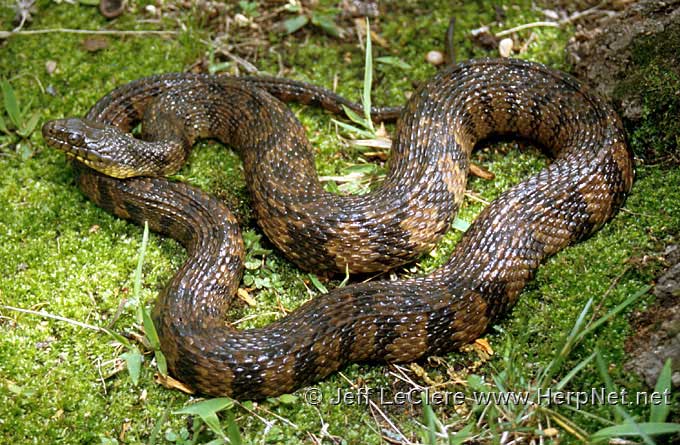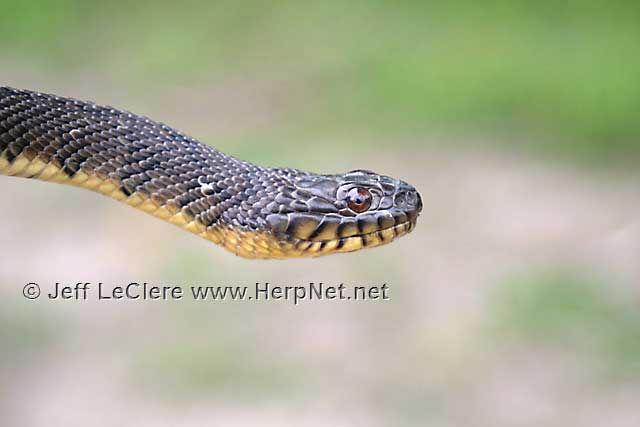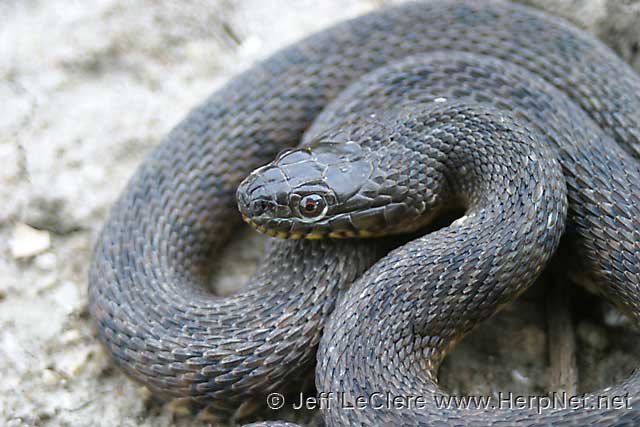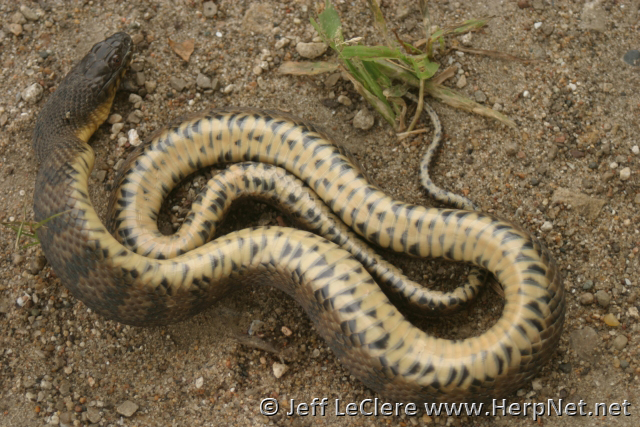Diamondback Water Snake (Nerodia rhombifer)
Alternate names: Diamond-Backed Watersnake
by Jeff LeClere

Status
THREATENED and Species of Greatest Conservation Need . It is illegal to kill or collect this species by law in Iowa.
Description
Harmless to humans. Diamondback water snakes range in length from 30 – 48 inches (76 – 122 cm). Max 63 inches (160 cm). Adults may be quite heavy bodied. The dorsal ground color is greenish, olive, brownish, or grayish. The common name “diamondback” is rather misleading because they do not have dark diamond shaped markings down the back. Rather, they have a somewhat chain-like pattern. There are small dark, square-like blotches down the middle of the back and large rectangular bars that extend up from the ventral scales. There are often small dark lines that connect the blotches to the bars and the tail is ringed. The belly is yellow or cream with brown half-moon shaped markings which may be sparse or absent in the center and become much more numerous at the edges of the belly. The labial scales and throat are usually bright yellow. Larger adults often appear solid brown or olive when they are dry. Females are larger than males and males may have small tubercles under the chin and on the dorsum above the vent. Newly born diamondback water snakes look like light colored versions of the adults and may have an orange wash on the belly.

Subspecies
The subspecies found in Iowa is the northern diamondback water snake, Nerodia rhombifer rhombifer.
Similar Species
Diamondback water snakes are most often confused with northern water snakes, which are much more common and have a larger range in Iowa. Northern water snakes have large cross bands on the neck and usually have reddish half moons on the belly. Northern water snakes are much more common in Iowa, are found in the same habitats, and their range not only completely overlaps that of the diamondback water snake in Iowa, but is found in most of the state where diamondback water snakes are not found. Double check the ranges; diamondback water snakes are found only in southeastern Iowa and are uncommon there, while northern water snakes are common throughout their much larger Iowa range. Other spotted snakes in Iowa typically lack the connectivity of the dorsal blotches to the lateral blotches by a relatively thin band of dark pigment. Diamondback water snakes superficially resemble the venomous cottonmouth, but cottonmouths are not found in Iowa.

Range
In Iowa, the diamondback water snake has been documented only from the southeastern area of the state. It is a very common water snake in states south and east of Iowa.
Habitat and Habits
The diamondback water snake is active from April to October. An inhabitant of rivers, sloughs, ponds, backwaters, and oxbows, most records are from waterways with abundant aquatic vegetation. In Iowa, it avoids clear gravelly streams and heavily wooded ponds. This rare water snake (in Iowa) is highly dependent upon the vegetative sloughs, ponds, and oxbows near the Mississippi River that support good amphibian populations. Destruction or modification of these important wetlands will negatively affect this species. Fortunately, most of the known Iowa range of this species is situated within the recently developed Southeast Iowa Herp Conservation Area. This snake is usually diurnal in spring and fall, however, during hot weather it becomes active at night. Diamondback water snakes may be observed basking upon branches, shrubs, tree roots, and along the banks of waterways. I have found young specimens hiding beneath debris at the water’s edge in Lee County. Overwintering takes place underground often in burrows, root systems, or other places below the frost line. When cornered, they will flatten their jaws and bodies striking viciously and repeatedly. If picked up, they will release an unpleasant musk and fecal matter.

Reproduction
Copulation probably takes place soon after emergence from winter dormancy. Many males may court one female at the same time and may rub the backs of females with the bumps on their chins. They will often select a basking perch such as a shrub or branch overhanging water for copulation. Breeding has also been observed on the banks of waterways or even in the water. During breeding, both snakes may make undulating movements with their bodies and they may mate for an hour or more. An average of 30 young may be produced in a single litter ranging from late August into October. A gravid female I found in Louisa County on 8 May gave birth to 24 young on 8 September. The young ranged from 11 – 12 ½ inches (270 – 319 mm) in length at birth and averaged 11 ½ inches (296 mm).
Food
Diamondback water snakes feed on a wide variety of animals associated with water. Fish, amphibians, baby turtles, young snakes, worms, leeches, insects, crayfish, and mammals may be consumed. Among fish, non game species are most often preyed upon. They hunt by patrolling the water along the shoreline for food. Prey is swallowed alive.
